Mustang 4.6L Three-Valve Dyno Runs
Home | Intake | CMDP | UDP | Exhaust | Suspension | Interior | Aerodynamics | Parts | Dyno | Bolt Ons | Engine | Coyote SwapWhen the 2005 Ford Mustang GT was launched in September 2004, enthusiasts groaned with disappointment when it came with a relatively undersized 4.6L 3V V8 engine producing 300hp & 320lbft while other muscle cars of the same era had 5.7L V8 engines producing 350hp & 365-390lbft. Although the 2005 Mustang GT gained 40hp & 18lbft over the 260hp & 302lbft 4.6L 2V engine that was fitted in the 1999-2004 Mustang GT, the newer model also gained more than 200lb and was therefore only slightly quicker down the 1/4 mile than the outgoing model's 14.0sec @ 100.2mph. Car & Driver magazine recorded a 1/4 mile time of 13.85sec @ 102.0mph while Motor Trend magazine recorded an almost identical 13.77sec @ 102.7mph. That was enough to comfortably beat the 14.24sec @ 101.4mph of the 600lb heavier 2006 Dodge Charger Daytona R/T, and run close to the 13.73sec @ 104.6mph of the 250lb heavier 2004 Pontiac GTO, but it stood no chance against the 100lb lighter 2002 Chevrolet Camaro Z28 SS as that ripped down the 1/4 mile in 13.49sec @ 107.34mph.
For little extra cost, Ford could so easily have further upgraded the 4.6L 3V engine to produce 365hp & 375lbft (see dyno 6 below), representing a massive 105hp & 73lbft gain over a stock 4.6L 2V engine. This would have given the 2005 Mustang GT the performance (1/4 mile time of 12.60sec @ 110.12mph with basic traction upgrades) to obliterate its rivals with a 1.1L smaller capacity engine that beat them for horsepower and matched them for torque! Such an achievement by Ford would have sent shockwaves through the muscle car world but this went down instead as a golden opportunity missed.
Fortunately, bolt-on upgrades and stroker engine parts are available for Mustang owners to add even more naturally-aspirated power and cubic inches according to their budget and performance goals, making it possible to surpass 400hp or even 450hp without resorting to a more costly and complex 5.0L Coyote engine swap.

Stock 2005 Mustang GT
264.17rwhp 284.63rwtq or 303hp 323lbft crank
Factory ratings 300hp @ 5750rpm & 320lbft @ 4500rpm
1/4 mile 13.77sec @ 102.45mph @ 3690lb
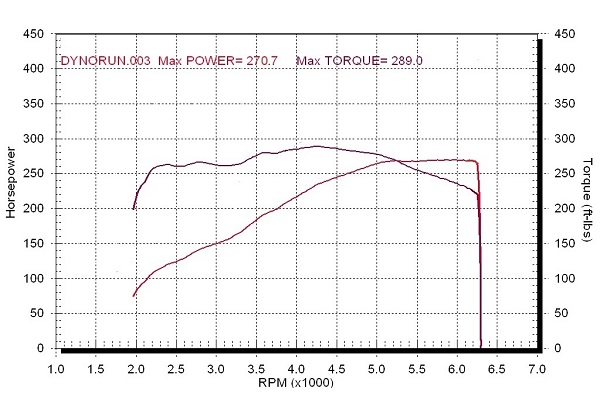
Stock 2006 Mustang GT
270.70rwhp 289.00rwtq or 311hp 328lbft crank
Factory ratings 300hp @ 5750rpm & 320lbft @ 4500rpm
1/4 mile 13.63sec @ 103.65mph @ 3690lb (3.55 axle gears)
Same as 2005 GT but without the restrictive hydrocarbon trap inside the intake tract, and with a revised ECU tune to correct an overly rich condition above 5100rpm. This resulted in the HP peak being carried further up the rpm range with a 10rwhp gain at the factory 6250rpm rev limiter.

Stock 2009 Mustang GT
274.54rwhp 290.52rwtq or 312hp 330lbft crank
Factory ratings 300hp @ 5750rpm & 320lbft @ 4500rpm
1/4 mile 13.59sec @ 103.36mph @ 3690lb (3.31 axle gears)

Stock 2008 Mustang Bullitt
278.41rwhp 292.84rwtq or 319hp 333lbft crank
Factory ratings 315hp @ 6000rpm & 325lbft @ 4250rpm
1/4 mile 13.62sec @ 103.81mph @ 3700lb
Same as 2006-2009 GT but with the 823cfm M-9703-GTB Ford Performance 83mm cold air intake, GTB mufflers, and a revised factory tune.

Stock 2010 Mustang GT
278.94rwhp 295.64rwtq or 321hp 336lbft crank
Factory ratings 315hp @ 6000rpm & 325lbft @ 4250rpm
1/4 mile 13.46sec @ 103.89mph @ 3750lb
Same as 2006-2009 GT but with a higher-flowing (800cfm) OEM air intake assembly and a revised factory tune.

Stock 2007 Shelby GT
281.29rwhp 302.71rwtq or 323hp 344lbft crank
Factory ratings 319hp @ 5750rpm & 330lbft @ 4500rpm
1/4 mile 13.62sec @ 104.40mph @ 3716lb
Same as 2006-2009 GT but with the M-9603-S463 Ford Performance 90mm cold air intake (identical to Steeda #555-3120), Ford Performance X-pipe, GTA mufflers, and a revised factory tune.
Dyno 1: JLT 3 Series Cold Air Intake
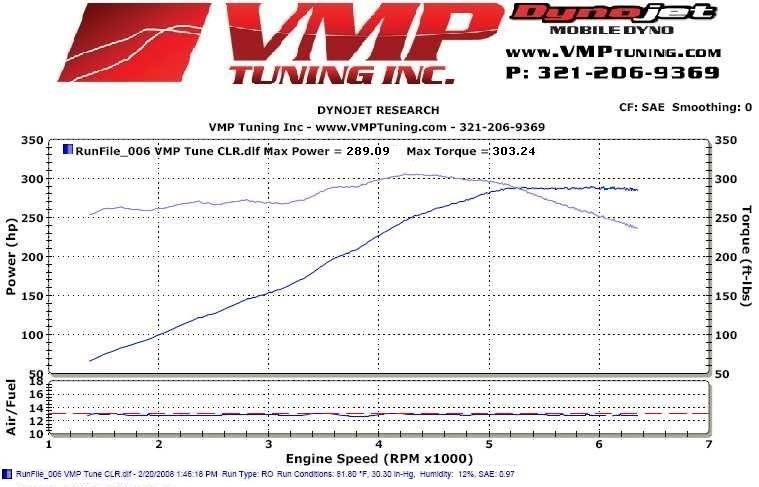
JLT 3 series cold air intake with a custom 91 octane tune.
289.09rwhp 303.24rwtq or 331hp 344lbft crank
The result is a gain of ~25rwhp & ~18rwtq on a stock 2005 GT, and a ~18rwhp & ~14rwtq gain on a stock 2006-2009 GT with torque gains across the whole rpm range. A great entry-level performance upgrade.
1/4 mile 13.20sec @ 106.25mph @ 3690lb
Dyno 2: Steeda Underdrive Pulleys

CAI, UDPs, and custom 91 octane tune.
298.51rwhp 311.36rwtq or 342hp 354lbft crank
1/4 mile 13.15sec @ 107.27mph @ 3690lb
1/4 mile 12.93sec @ 107.43mph @ 3690lb (with basic traction upgrades)
Dyno 3: Charge Motion Delete Plates

CAI, UDPs, CMDPs, and custom 91 octane tune (same performance upgrades added to the 2008 Steeda Q350).
Parts cost only ~$875 if you convert your existing charge motion control valve assembly into delete plates.
304.40rwhp 320.10rwtq or 349hp 364lbft crank
1/4 mile 12.85sec @ 108.27mph @ 3690lb
Dyno 4: Ford Performance X-pipe (GT350 Package)

Same as dyno 3 but with a Ford Performance cut/clamp X-pipe from the 2007 Shelby GT that retains the stock cats. The same package of upgrades is featured in the Episode 1 Brenspeed High Mile 3V Mustang
305.87rwhp 324.16rwtq or 351hp 368lbft crank
Impressive numbers considering the car merely had simple "stage 1" bolt-on performance upgrades plus a custom ECU tune. Parts cost ~$1075.
1/4 mile 12.83sec @ 108.47mph @ 3690lb
Dyno 5: Off-road X-pipe

Same as dyno 4 but with the stock cats deleted.
312.48rwhp 326.69rwtq or 359hp 371lbft crank
The result is an ~8rwhp ~6.5rwtq gain over a stock midpipe with ~6.5rwhp ~2.5rwtq gained from deleting the stock cats, but torque gains only appear above 3500rpm with virtually no change at lower rpm. It's also non-compliant with emissions regulations in many states and is thus designated for "offroad use only". This represents the best bang-per-buck bolt-on performance combination in terms of parts cost (~$1145) and ease of installation.
Dyno 6: My 2006 Mustang GT
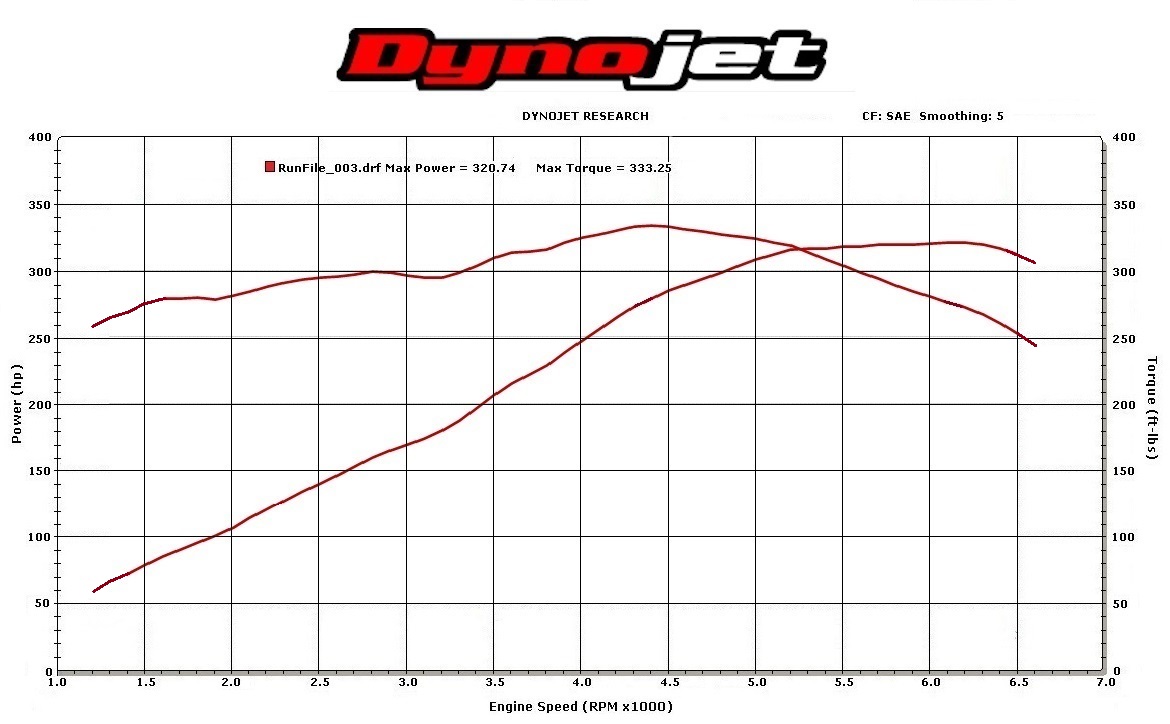
Same as dyno 4 but with a DIY ported stock throttle body, JBA replica shorty headers, Pypes high-flow cats, and a DSS aluminum driveshaft.
320.74rwhp 333.25rwtq or 365hp 375lbft crank
Outputs match those of a stock Gen 1 F-150 5.0L Coyote engine with simple external performance parts plus a 91 US octane (95 RON octane) tune that should have been original equipment on the car! At least 300rwtq (90% of maximum torque) is available from 3350-5550rpm with 295-300rwtq on tap from 2500-3350rpm. Parts cost ~$1300 (excluding driveshaft).
1/4 mile 12.60sec @ 110.12mph @ 3630lb
Further HP/TQ gains beyond this point come at considerably higher cost. Therefore this represents the best value for money performance for budget minded 2005-2010 Mustang GT owners.
Dyno 7: 3/4 Length LT Headers

Same as dyno 5 but with 3/4 length 1-5/8" headers instead of the stock exhaust manifolds, as featured in the Episode 2 Brenspeed High Mile 3V Mustang.
320.49rwhp 333.03rwtq or 368hp 378lbft crank
The result is a ~16rwhp ~13rwtq gain over a stock exhaust system (dyno 3), and a ~8rwhp ~6.5rwtq gain over the stock exhaust manifolds with off-road X-pipe (dyno 5). At least 300rwtq is available from 3400-5600rpm. Parts cost ~$1879.
1/4 mile 12.69sec @ 109.71mph @ 3690lb
Another almost identical combination but with a dual 62mm throttle body and a one-piece aluminium driveshaft put down 327rwhp & 339rwtq or 371hp 381lbft crank.
Dyno 8: Full Length LT Headers

Same as dyno 5 but with full length 1-5/8" headers instead of the stock exhaust manifolds.
321.27rwhp 337.78rwtq or 369hp 384lbft crank
The result is a ~17rwhp ~17.5rwtq gain over the stock exhaust system (dyno 3), and a ~9rwhp ~11rwtq gain over the stock exhaust manifolds with off-road X-pipe (dyno 5). Full length 1-5/8" headers produce the biggest torque gains from 2700-5300rpm where reflected pressure wave scavenging is strongest, and at least 300rwtq is available from 2700-5600rpm. Parts cost ~$1879.
1/4 mile 12.63sec @ 110.16mph @ 3690lb
 Dyno 9: Full Bolt Ons
Dyno 9: Full Bolt Ons
Same as dyno 8 but with the addition of a dual 62mm throttle body, Meziere electric water pump, 3.5" aluminum driveshaft, and 12lb lightweight flywheel.
334.94rwhp 347.70rwtq or 376hp 386lbft crank
The result is a ~14rwhp ~10rwtq gain with ~8.5rwhp ~7.5rwtq recovered by reducing drivetrain losses. These outputs are the maximum possible from the stock cylinder head, camshaft, and intake manifold (HCI) combination.
Dyno 10: Best Daily Driver Combination

Same as dyno 8 but with the addition of stage 1 CNC ported heads, a dual 62mm throttle body, and a 3.5" aluminum driveshaft.
338.80rwhp 346.20rwtq or 385hp 389lbft crank
This combination produces excellent low rpm torque for the best possible highway fuel economy on stock axle gearing while the ported heads improve higher rpm breathing. The result is a broad torque curve, with at least 300rwtq available from 2700-5900rpm, for excellent street performance all the way from idle to 6600rpm. CNC ported heads and a 62mm throttle body are expensive, and thus yield too little bang for the buck, but the good news is that DIY porting your existing stock heads and stock 55mm throttle body could save a whopping ~$3570. The results are rewarding with the proper tools and knowledge, and maximum HP/TQ outputs would match those of a stock Gen 2 F-150 5.0L Coyote engine. Parts cost ~$5589 (or ~$2019 if DIY).
1/4 mile 12.49sec @ 111.87mph @ 3690lb
Adding a Meziere electric water pump and a 12lb aluminum flywheel (i.e. dyno 9 + stage 1 CNC ported heads) would raise outputs to 347rwhp & 353rwtq or 390hp & 392lbft at the crank, maximizing performance from the stock camshaft/intake manifold combination while minimizing drivetrain losses.
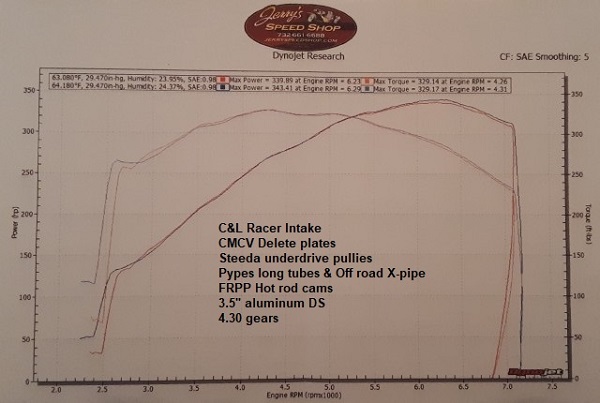 Dyno 11: Hot Rod NSR Camshafts 1
Dyno 11: Hot Rod NSR Camshafts 1
Same as dyno 7 but with the popular Ford Performance Hot Rod NSR camshafts instead of the stock camshafts.
341.65rwhp 329.16rwtq or 391hp 374lbft crank
That's a peak ~21rwhp gain and ~4rwhp loss over the stock camshafts, with torque gains only from 5100+rpm. From 3500-5000rpm, torque output is virtually unchanged from the stock camshafts but below 3500rpm, torque output is reduced with a 20+rwtq loss between 2500-3000rpm. The power band is shifted higher up the rpm scale with at least 300rwtq available from 3400-5900rpm. Parts cost ~$3190.
Dyno 12: Hot Rod NSR Camshafts 2

Same as dyno 11 but with full length headers instead of the more popular "tuner friendly" 3/4 length headers.
342.50rwhp 335.00rwtq or 393hp 381lbft crank
The result is a small increase in midrange torque since the inertial scavenging effect of the longer primary tube length of these headers is more effective.
Also same as dyno 8 but with the popular Ford Performance Hot Rod NSR camshafts instead of the stock camshafts (peak ~21rwhp gain and ~3rwhp loss). At least 300rwtq is available from 3300-6000rpm. Parts cost ~$3190.
Dyno 13: Brenspeed Detroit Rocker NSR Camshafts

Same as dyno 7 but with Brenspeed Detroit Rocker camshafts instead of the stock camshafts, as featured in the Episode 2 Brenspeed High Mile 3V Mustang.
343.48rwhp 328.91.03rwtq or 392hp 374lbft crank
The result is a ~23rwhp gain and 4rwtq loss over the stock camshafts, with an average 15rwtq loss between 2000-3300rpm. At least 300rwtq is available from 3500-5900rpm. Parts cost ~$3190.
1/4 mile 12.55sec @ 111.74mph @ 3690lb
Dyno 14: Mutha Thumpr NSR Camshafts (GT400 Package)

Same as dyno 8 but with CompCams Mutha Thumpr camshafts #127020 instead of the stock camshafts. These are the longest duration camshafts available that don't require upgraded valve springs or phaser limiters. They also produce a rough thumping idle quality, hence the name.
351.55rwhp 333.89rwtq or 400hp 379lbft crank
That's a peak ~30rwhp gain and ~4rwhp loss over the stock camshafts, with torque gains only from 5000rpm upwards. Below 5000rpm, torque output is reduced with a ~15-20rwtq loss between 2500-3000rpm, and at least 300rwtq is available from 3400-6100rpm. Parts cost ~$3190.
1/4 mile 12.44sec @ 112.94mph @ 3690lb
1/4 mile 11.97sec @ 113.92mph @ 3580lb (with advanced traction upgrades & 4.56 axle gears)
Dyno 15: Ford Performance Intake Manifold & 62mm Throttle Body
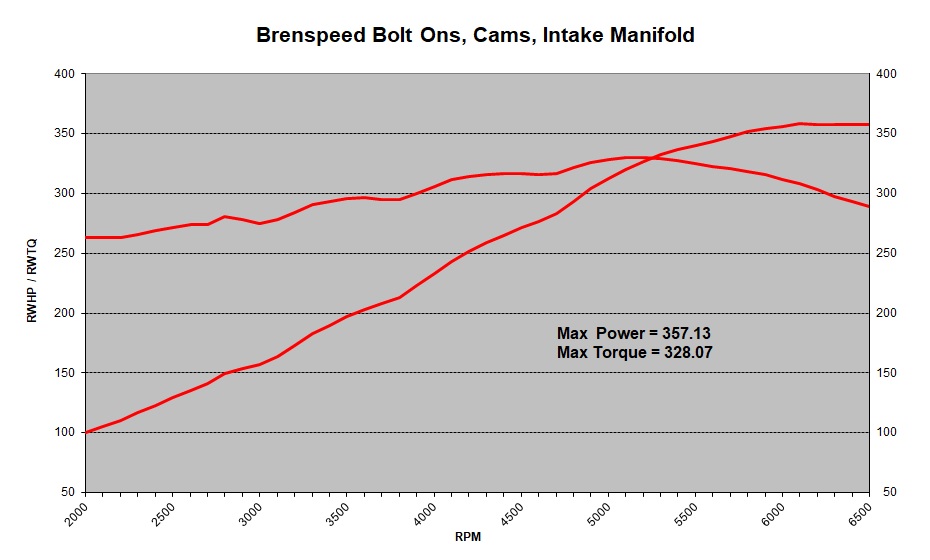
Same as dyno 13 but with the Ford Performance intake manifold and 62mm throttle body instead of the stock intake manifold with charge motion delete plates and stock 55mm throttle body, as featured in the Episode 3 Brenspeed High Mile 3V Mustang.
357.13rwhp 328.07rwtq or 407hp 373lbft crank
The result is a ~14rwhp gain but with a loss of up to 12rwtq between 3500-4800rpm. At least 300rwtq is available from 3900-6200rpm. Parts cost ~$4660.
1/4 mile 12.47sec @ 113.05mph @ 3690lb
1/4 mile 11.96sec @ 114.00mph @ 3580lb (with advanced traction upgrades & 4.56 axle gears)
Another almost identical combination but with a one-piece aluminium driveshaft instead of the stock steel unit put down 363rwhp & 333rwtq or 409hp 375lbft crank.
Dyno 16: Stage 1 Ported Heads & Cams

Same as dyno 14 but with stage 1 CNC ported heads & 62mm throttle body.
365.94rwhp 344.76rwtq or 413hp 388lbft crank
That's a peak gain of 13hp and 9lbft compared to the dyno run with the stock heads. Torque output is increased from 3200rpm upwards with no loss of torque at lower rpm. At least 300rwtq is available from 3400-6400rpm, and maximum HP/TQ outputs match those of a stock Gen 1 Mustang 5.0L Coyote engine. Note that the stock 24lb/hr fuel injectors reach their maximum duty cycle at this power level. Parts cost ~$6900.
1/4 mile 11.89sec @ 114.67mph @ 3580lb (with advanced traction upgrades & 4.56 axle gears)
Dyno 17: Stage 3 Ported Heads & Cams

Same as dyno 14 but with stage 3 CNC ported heads, a dual 62mm throttle body, and 39lb/hr injectors.
380.85rwhp 348.39rwtq or 429hp 391lbft crank (SAE corrected)
That's a peak gain of 29hp and 13lbft compared to the dyno run with the stock heads and throttle body. However, the torque output is only increased from 4800rpm upwards and there's a slight torque loss below 4700rpm. The power band is shifted higher up the rpm scale with at least 300rwtq (SAE) available from 3900-6500rpm. Parts cost ~$8600.
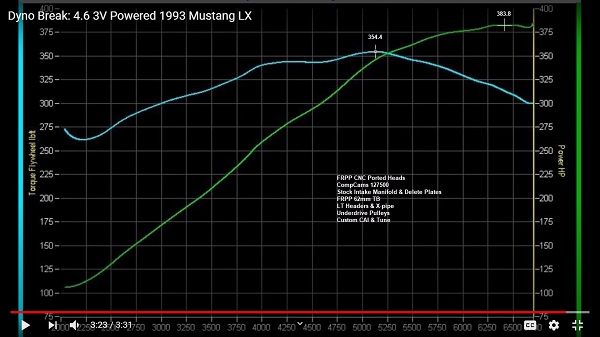 Dyno 18: Maximum Torque Combination
Dyno 18: Maximum Torque Combination
Same as dyno 17 but with XFI 127500 SPR camshafts instead of the Mutha Thumpr NSR.
383.80rwhp 354.40rwtq or 432hp 398lbft crank
The higher valve lift of these camshafts takes full advantage of the increased airflow of the stage 3 ported heads, permitting increased cylinder filling and torque production even at lower rpm. The result is a fatter torque curve with at least 300rwtq available from 3000-6650rpm and at least 340rwtq on tap from 4000-5700rpm. Maximum HP/TQ outputs match those of a stock Gen 2 Mustang 5.0L Coyote engine. Parts cost ~$8868.
1/4 mile 11.87sec @ 116.03mph @ 3595lb
Another almost identical combination but with a 22lb stock flywheel instead of a 12lb lightened version put down 379.2rwhp 350.0rwtq SAE and ran the 1/4 mile in 11.78sec @ 115.84mph @ 3565lb.
Dyno 19: Maximum HP Combination (HCI)

Same as dyno 18 but with a JPC intake manifold.
393.60rwhp 348.90rwtq or 449hp 396lbft crank
The JPC manifold produces more HP & torque than the stock manifold with CMDPs from 5300rpm upwards but where HP production with the stock manifold tails off at 6300rpm, the JPC manifold continues making HP all the way to 7000rpm. Although the peak-to-peak HP gain is ~20rwhp, the difference increases to a whopping ~40rwhp at 7000rpm.
Below 5300rpm the torque output is reduced by up to ~16lbft with the characteristic double hump 4300rpm & 5100rpm torque peaks of the stock intake manifold being truncated. At least 300rwtq is available from 3500-6900rpm. Parts cost ~$9568.
1/4 mile 11.78sec @ 116.97mph @ 3650lb
Dyno 20: 302ci Stroker & HCI

Combining a 3.800" stroker crankshaft with the 3.554" cylinder bore of an honed 3V block increases displacement from the stock 281ci (4601cc) to 302ci (4942cc). The compression ratio is also increased to 10.5:1 when using pistons with a 6cc dish.
This stroker combination was dressed with Livernois stage 3 ported heads, XFI 127600 SPR camshafts, Livernois cam phaser limiters, FRPP intake manifold, FRPP dual 62mm throttle body, FRPP 39lb injectors, SPEC 12lb aluminum flywheel, and a Shaftmaster aluminum driveshaft. Parts cost ~$12876.
413.32rwhp 359.49rwtq or 464hp 399lbft crank (SAE corrected)
This represents the pinnacle of N/A performance from an OEM 4.6L 3V aluminum engine block.
Another almost identical combination put down 410rwhp & 364rwtq or 460hp 404lbft crank.
Dyno 21: 323ci Big Bore Stroker & HCI

Combining a 3.750" stroker crankshaft with the 3.700" cylinder bore of the FRPP Boss Modular 5.0L cast iron block increases displacement to 323ci (5286cc). This stroker combination is similar to the previous 302ci stroker combination apart from the bigger displacement and an 11.2:1 compression ratio. Parts cost ~$15266.
426.09rwhp 384.37rwtq or 479hp 427lbft crank
The Boss 5.0L block was conceived to handle 1000+HP at the crank, and a 323ci N/A stroker build making less than half of that really doesn't do it justice despite matching the awesome Gen 3 Mustang Bullitt/Mach 1 5.0L Coyote engine for power. Consequently this block is far more popular in high HP forced induction applications such as this 875rwhp 800rwtq twin turbo set up, and this 887rwhp 745rwtq 4.0L Whipple supercharged set up, where its potential can be fully exploited. Alternatively, an OEM 4.6L 3v aluminum block with 3.700" bore cylinder sleeves could be used for a 65lb weight saving.